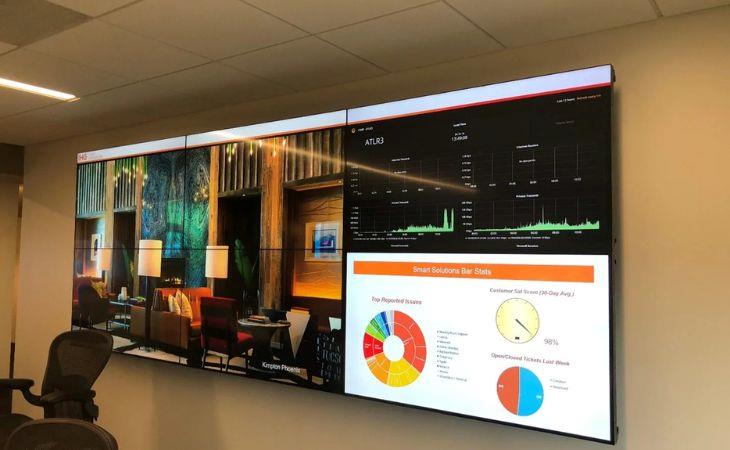
How Does Digital Signage Enhance Business Intelligence?
Digital signage serves as a powerful tool for enhancing business intelligence, offering a wide range of features that provide valuable insights and drive informed decision-making. Let's explore why cloud based digital signage is crucial for business intelligence and examine 20 ways it can optimize intelligence gathering and analysis.
Why is Digital Signage Important For Business Intelligence?
In today's fast-paced business landscape, data-driven decision-making is essential for staying competitive and meeting customer expectations. Digital signage plays a vital role in transforming raw data into actionable insights. Studies have shown that businesses leveraging digital signage for business intelligence experience significant improvements in operational efficiency, customer engagement, and overall performance.
Research conducted by Forbes indicates that companies using digital signage for business intelligence see a 35% increase in customer satisfaction and a 32% improvement in employee productivity. This highlights the significant impact digital signage can have on various business operations.
20 Ways to Use Digital Signage For Enhancing Business Intelligence
Real-time Data Display
Digital signage enables businesses to showcase real-time data, like sales figures and social media mentions, offering stakeholders instant insights for informed decisions. TV Dashboards provide an effective way to visualize key performance metrics, ensuring that executives, employees, and decision-makers have instant access to critical business data. This dynamic display of information fosters a responsive environment where timely actions can be taken to capitalize on emerging trends and opportunities. Additionally, real-time data display enhances transparency and accountability within the organization by keeping all stakeholders informed about the latest developments.
Data Visualization
Presenting data in visually appealing formats, such as heatmaps and infographics, enhances comprehension and facilitates actionable insights for stakeholders. This visual representation of data promotes collaboration and engagement among team members, fostering a data-driven culture within the organization.
Targeted Messaging
Demographic information and past purchasing behavior enable businesses to tailor messages according to customer preferences, maximizing relevance and effectiveness. Additionally, integrating real-time location data allows for contextually relevant messaging, further enhancing customer engagement. This targeted approach improves the overall customer experience and boosts brand loyalty and long-term customer relationships.
Integration with Business Systems
Seamless integration with various business systems streamlines data flow and eliminates silos, enabling a holistic understanding of business performance. By connecting digital signage with inventory management systems, businesses can dynamically showcase product availability and promotions, enhancing the shopping experience for customers. Moreover, integrating with CRM software allows personalized content delivery based on individual customer profiles, promoting more robust relationships and driving repeat business.
Interactive Engagement
Engagement metrics collected from interactive touchscreens and surveys offer valuable insights into customer preferences and behaviors, informing future marketing strategies and product offerings. Additionally, gamification elements within digital signage encourage prolonged interaction, increasing brand awareness and customer loyalty. Businesses can refine their messaging and tailor promotions by analyzing user interactions with interactive content to better resonate with their target audience.
Remote Management and Analytics
With remote management capabilities, businesses can quickly update content and respond to changing market conditions in real time, maximizing the effectiveness of their digital signage campaigns. Furthermore, cloud-based analytics provide actionable insights into audience demographics, content engagement, and campaign performance, facilitating data-driven decision-making. By harnessing the power of remote management and analytics, businesses can streamline operations, optimize content delivery, and achieve more significant ROI from their digital signage investments.

A/B Testing and Experimentation
Through A/B testing, businesses can compare the effectiveness of different messages, visuals, and calls-to-actions, refining their strategies to better resonate with their target audience. This iterative process empowers companies to make data-backed decisions, continuously improving the impact and ROI of their digital signage efforts.
By adopting A/B testing, businesses can stay agile and responsive to evolving customer preferences and market trends, driving ongoing success in their business intelligence endeavors.
Employee Communication and Engagement
In addition to disseminating company news, digital signage can serve as a platform for recognizing employee achievements and milestones, fostering a positive work environment, and boosting morale. By providing relevant and timely information, businesses can ensure that employees stay informed about important updates and initiatives, enhancing transparency and alignment across the organization. Furthermore, interactive features such as employee surveys and feedback forms, tailored specifically for enterprise environments, facilitate two-way communication. These tools empower employees to voice their opinions, share insights, and actively contribute to decision-making processes within the organization. Such enterprise-centric features not only enhance employee engagement but also foster a culture of transparency and collaboration, ultimately driving organizational success.
Integration with IoT Devices
Through integration with IoT devices, digital signage can gather real-time data on foot traffic, dwell time, and customer interactions, providing valuable insights into consumer behavior. This data can be leveraged to deliver targeted content and promotions, enhancing the overall customer experience and driving sales. Additionally, IoT-enabled signage can trigger automated actions based on predefined conditions, such as displaying relevant information when a customer approaches a particular product display, further enhancing engagement and convenience.
Enhanced Customer Journey Mapping
By analyzing customer interactions with digital signage along various touchpoints, businesses can gain insights into the effectiveness of their marketing strategies and identify areas for improvement. This comprehensive understanding of the customer journey allows for creating personalized experiences tailored to individual preferences and needs. Furthermore, enhanced customer journey mapping enables businesses to anticipate customer behavior and adapt their messaging accordingly, fostering deeper engagement and long-term loyalty.
Localized and Contextual Messaging
Utilizing geotargeting capabilities, digital signage can deliver localized messages based on the demographics and preferences of the target audience in different regions. By contextualizing content to fit the surroundings or current events, businesses can improve relevance and effectively capture the attention of passersby.
This personalized approach increases engagement and promotes a sense of connection between the brand and its local customer base, ultimately driving conversion and loyalty.
Feedback Loop Integration
Businesses can gather valuable customer insights through feedback loop integration through surveys, social media mentions, and other feedback channels directly on digital signage displays. This real-time feedback allows businesses to promptly address concerns, improve customer satisfaction, and refine their products or services accordingly. Additionally, by actively seeking and responding to customer feedback, businesses demonstrate social responsibility and a commitment to meeting the needs and expectations of their clientele, fostering trust and goodwill within their communities.
Dynamic Content Adaptation
Dynamic content adaptation in digital signage allows businesses to tailor their messaging based on external factors like weather conditions, time of day, and the demographics of the audience present. By leveraging data on these variables, companies can ensure that their content remains relevant and engaging, increasing the effectiveness of their communication efforts. This adaptability enhances the overall impact of digital signage by delivering personalized experiences that resonate with viewers, ultimately driving stronger engagement and influencing behavior.

Competitor Analysis and Benchmarking
Competitor analysis and benchmarking in digital signage involve monitoring competitors' activities and comparing performance metrics against industry standards. This allows businesses to identify areas for improvement and stay ahead of their competition.
By analyzing competitor strategies and performance, companies can adapt their approaches to better meet market demands and achieve their business goals. This proactive approach to competition fosters innovation and ensures businesses remain competitive in their respective industries.
Customer Sentiment Analysis
Customer sentiment analysis involves analyzing social media mentions, reviews, and customer feedback to gain insights into trends and sentiments regarding a brand or product. By understanding customer perceptions, businesses can identify areas for improvement and adjust their strategies accordingly. This proactive approach enables companies to address concerns, enhance customer satisfaction, and ultimately improve brand perception and loyalty. Leveraging sentiment analysis allows businesses to build stronger relationships with their customers and maintain a positive brand reputation in the market.
Operational Efficiency Metrics
Operational efficiency metrics tracked through digital signage, such as wait times, queue lengths, and inventory levels, provide valuable insights into business operations. Businesses can identify bottlenecks, streamline processes, and allocate resources more effectively by analyzing this data. The proactive approach to operational management improves overall efficiency, reduces costs, and enhances the customer experience.
Integration with Customer Relationship Management (CRM) Systems
Integration with Customer Relationship Management (CRM) systems allows businesses to leverage customer data for personalized digital signage content. Businesses can tailor messaging to individual preferences and behaviors by analyzing customer profiles and purchase history, improving relevance and engagement. This integration enhances the customer experience, fostering stronger relationships and increasing the likelihood of conversion. Leveraging CRM data in digital signage strategies empowers businesses to deliver targeted messages that resonate with their audience, ultimately driving sales and loyalty.
Continuous Improvement Initiatives
Continuous improvement initiatives leverage digital signage analytics to identify performance gaps and areas for enhancement. Implementing targeted improvements based on content effectiveness analysis, audience engagement, and conversion rates allows organizations to adapt quickly to changing market conditions and customer preferences. This iterative approach encourages continuous growth and optimization, ensuring that digital signage remains an effective tool for driving business success.
Real-time Sales Performance Tracking
Real-time sales performance tracking empowers businesses to swiftly identify emerging trends, anticipate shifts in demand, and make informed decisions to optimize revenue streams. Organizations gain valuable insights into market dynamics and consumer preferences by closely monitoring sales metrics such as transaction volumes, product popularity, and customer behavior in real time.
Using this data-driven methodology allows businesses to make early adjustments to sales strategies and inventory management practices that will respond to changing market conditions and maximize potential revenue.
Customer Behavior Heatmaps
Analyzing customer behavior heatmaps generated by digital signage interactions provides insights into customer preferences, helping businesses tailor their offerings and marketing strategies accordingly.
Key Takeaways
Digital signage serves as a powerful tool for improving business intelligence by providing real-time data display, data visualization, targeted messaging, and integration with business systems.
Businesses can gain valuable insights into customer behavior, optimize operations, and drive growth by leveraging free digital signage solutions for interactive engagement, remote management and analytics, A/B testing, and employee communication.
With continuous improvement initiatives and real-time sales performance tracking, digital signage enables businesses to stay competitive and agile in today's rapidly evolving market landscape.
More From Our Blog
-

Screen Sharing for Workplace Collaboration | Rise Vision
Screen-sharing technology has transformed how teams communicate and work together in real-time, regardless of their location. It can make presentations more engaging, support remote work, and speed[…]
Read More -

How to Use PowerPoint for Digital Signage
To create stunning, attention-grabbing, and effective digital signage content, you need the help of content creation and presentation tools. One of the most popular is Microsoft PowerPoint, owing to[…]
Read More -

120 Digital Signage Content Ideas
So…. you decided you would invest in some digital signage software and you need some ideas for ways you can make it stand out. This article is your go-to source for the best digital signage content[…]
Read More
Keep Your Displays Interesting – Pick New Templates Every Week!
Every week, we send template recommendations that will make you look great and improve your audience experience. And the best part, they save up to 16 hours of content creation time every week!
12,300+ Organizations Trust Rise Vision, You Can Too
Schedule a Free Demo
You deserve the #1 all-in-one platform for digital signage, screen sharing, and emergency alerts.



































